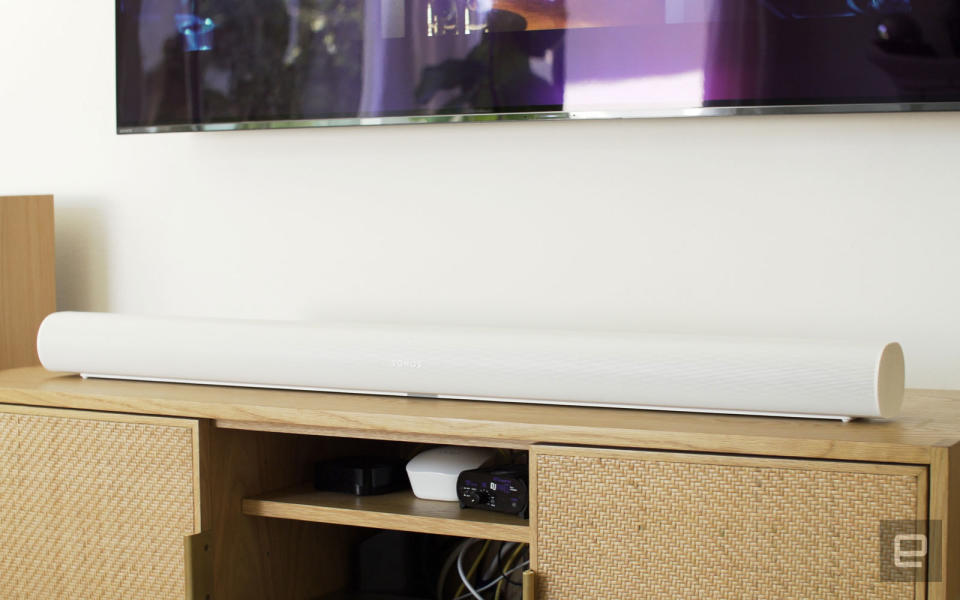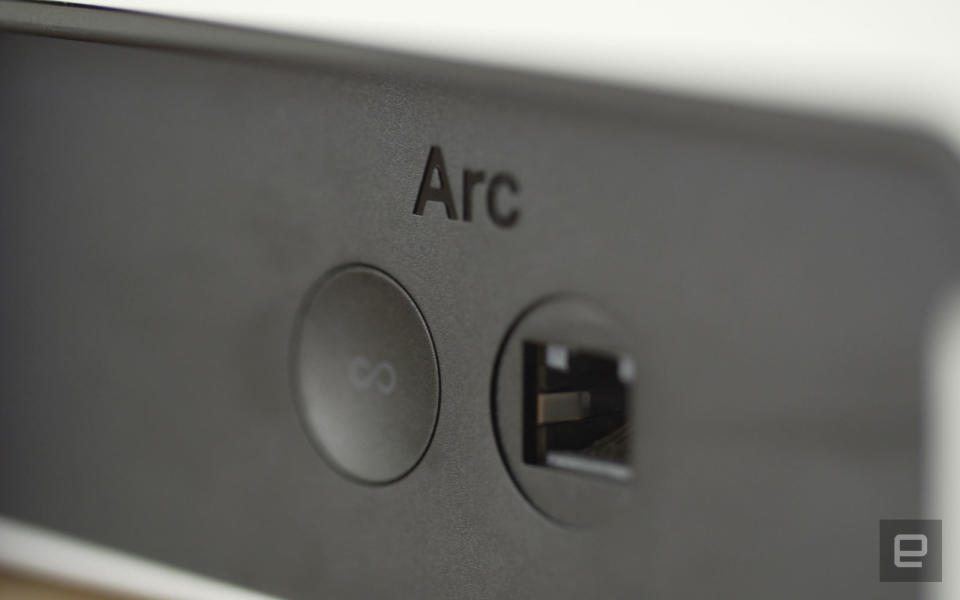Sonos Arc review: An upgrade worth the wait
Improvements all around, including the addition of Dolby Atmos.
Sonos first debuted the Playbar in 2013. Since then, the company has introduced the Playbase (2017) and compact Beam soundbar (2018). But for those who wanted a more robust arrangement with either a soundbar on its own or one paired with a sub and/or satellite speakers, the Playbar was still your best bet. However, that device is seven years old, so it’s hard to justify investing in one.
Enter the Arc ($799): a completely redesigned soundbar that offers all that we’ve come to expect from recent Sonos products, plus Dolby Atmos audio, and one potentially big headache.
You can tell this is a drastically different device at first glance. The Arc looks more like modern Sonos gear. Instead of the gray-and-black two-tone units of the mid-2010s, it’s an all-black or all-white soundbar with tone-on-tone Sonos lettering in the center of the front. That aesthetic choice continues a preference the company has had for a while: speakers that blend in rather than stand out. The Arc is nearly 10 inches wider than the Playbar (45 inches total), which is necessary to accommodate the two additional drivers, but it’s not quite as deep. Sonos also softened the design into a rounded cylinder instead of a boxy rectangle.
The onboard controls were moved from the right side to the top center, and they’re now touch instead of physical buttons. They’re much easier to access here. On the Arc itself, you can play/pause, adjust volume and swipe to skip tracks. There’s also an option on the speaker to mute the microphones used for Alexa and Google Assistant voice controls. A set of tiny status LEDs above the Sonos logo give you some visual feedback so you know when it’s actually registering your commands.
Last, the Arc’s mounting hardware is on the back, so it’s facing the same direction whether you put it on a TV stand or on the wall. That’s unlike the Playbar, which pointed the speakers at you directly when mounted but fired sound at the ceiling when placed on a TV stand. An Arc-specific wall mount will cost you an extra $79 though.

Like the Beam, your connectivity options are limited on the Arc. There’s one HDMI port, an Ethernet jack and the power input. It’s enough to connect to your TV, but you’re not going to be able to hook up all of your streaming boxes and game consoles directly. This is intentional. Sonos keeps things simple by using an HDMI output from your TV, which allows you to still use your television remote, or a remote from a connected streaming device, to control volume. Of course, there’s also wireless connectivity over WiFi, and the Arc supports AirPlay 2.
Everything else is plugged into your TV, and the audio is routed via HDMI — ARC or eARC required. There is an optical audio adapter in the box, but that won’t do you much good if you’re buying the Arc for the Dolby Atmos compatibility. The main issue here is that you’ll need to make sure your TV supports Dolby Atmos passthrough to ensure you get the sound quality you’re seeking. Not all TVs are created equal here. If you have an HDMI eARC output though, you’re golden. You’ll get uncompressed 5.1 and 7.1 audio in all of its glory, thanks to the higher bitrate.
Similar to previous Sonos speakers, the Arc can calibrate itself to your living room with the company’s Trueplay technology. With Sonos’ S2 update, it now factors in height. Using the mic on an iOS device, the software tunes the speaker accordingly in just a few minutes. It’s quick and easy, and just like the initial setup, the Sonos app provides clear directions the whole way.
Inside, the Arc packs in eight elliptical woofers and three angled tweeters. There are also 11 digital amplifiers that Sonos says are “perfectly tuned” for the speaker’s acoustics. Those are all assigned dedicated left, right and center channels alongside surround left/right and upward firing audio to create an immersive experience in a 5.0.2 system.

As part of the S2 firmware, a number of behind-the-scenes tricks automatically adjust to content, orientation and additional speakers. If you’re watching a movie or show that doesn’t have Atmos, the Arc will retask the upward firing speakers for improved bass. If you add a Sub (which has also been updated), the Arc will tweak its tuning for more mids and highs. Last, if you splurge for a pair of Sonos One speakers to go behind your couch, the surround channels in the Arc will be tasked with producing more low end. Best of all, this all happens quietly, without you having to do anything.
While you can add extra Sonos gear to your setup as you see fit, the Arc is a massive sonic upgrade over the Playbar. Even without Atmos, you can tell a huge difference in bass performance and directional sound. Of course, if you want the full-blown experience or if you have a large living room, you might want to consider extra purchases. However, most people won’t need any.
I’ve been using the Playbar + Sub combo for several years. I could immediately recognize the audio-quality upgrade moving from the old soundbar to the Arc. I also tested the Arc with a Sub (second generation) and two One SLs, all configured in a surround sound setup. I tried the Arc and two One SLs (no Sub) too. My living room isn’t huge, but it does have some ceiling overhangs that are an acoustic nightmare. I preferred the Arc and Sub duo to any of the other options. I listen to a lot of music via my living room Sonos setup, and that habit greatly benefits from the Sub. However, when I was just watching TV with the Arc alone, I didn’t miss that extra speaker.

The full system with the Arc, Sub and two One SLs is great for movies, as you get even more of the Atmos effect. It’s also expensive. Again, the good news is you can add to the soundbar gradually. Setting up new speakers in the Sonos app takes about five minutes, and that includes retuning everything with Trueplay. I’m not a huge movie buff, so I’m not sure I could justify shelling out almost $2,000 to go all in. However, if you like Sonos-specific features and you want all the immersion you can get out of Dolby Atmos, I doubt you’ll be disappointed. My advice is to start with the Arc and see what you need to add on later.
Plenty of soundbars offer Dolby Atmos support, but the Arc also doubles as a great-sounding speaker for music. In fact, I was impressed with the bass performance of the soundbar itself when it came to streaming Spotify and Tidal. I’ve tested soundbars with a dedicated sub that didn’t sound this good. There’s enough low end to handle hip-hop and other bass-focused genres with ease, but it’s also restrained enough to help you avoid annoying your neighbors (to a certain extent). Sure, the Sub adds more thump, but again, most users will do fine with the Arc on its own. To me, the Arc itself has a bit too much treble at higher volumes, but I was able to adjust accordingly in the app for those raucous sessions.
Tidal recently announced Dolby Atmos Music support for compatible soundbars and TVs. It also works with Apple TV, Fire TV, Nvidia Shield TV and Shield TV Pro alongside some smart TVs from Sony and Philips. If you’re unfamiliar, Dolby Atmos Music is Sony’s 360 Reality Audio. It’s a more immersive listening experience that offers more clarity and detail in the music. Or, as Tidal explains it, the format ”puts you more directly in touch with the artist’s vision without compromise.” You can certainly tell a difference on the Arc when flipping back and forth between Tidal HiFi and Spotify, but the selection of songs is still limited. Plus, you’ll have to commit to a pricier subscription to get access.

If you aren’t happy with the factory tuning, the Sonos app offers an adjustable EQ. Here, you can tweak bass and treble or turn on loudness, which adjusts certain frequencies that might get lost when listening at lower volumes. You can also deactivate the Trueplay tuning or retune as needed (like if you add more speakers). When you’re watching TV there are two handy features: Night Mode increases quiet sounds and reduces loud ones while Speech Enhancement focuses on dialog by enhancing “the audio frequencies associated with the human voice.”
In terms of content, you can sync streaming services like Amazon Music, Apple Music, Spotify, Tidal and more. Apps like Pocket Casts and Calm are also on the list, so you can get access to much more than music. Plus there’s Sonos Radio, which provides streams of radio stations and original content. Basically, the Sonos app can be your one-stop media library — at least in terms of audio.
And we haven’t even discussed voice control yet. Like previous Sonos speakers, the Arc works with either Alexa or Google Assistant. Thanks to four far-field beamforming microphones and echo cancellation, those two voice technologies can turn on the TV, adjust the volume or handle any of their regular duties — even while something is playing. If your television and other smart devices support those voice options, the features will likely be more robust, but know that the Arc will handle the basics right out of the box.

At $799, the Arc is a significant investment. As I’ve already mentioned, it’s $100 more than the Playbar, and Sonos no longer offers the Playbase. (Both are in the Last Chance section of the Sonos online store while supplies last.) If you aren’t interested in Atmos and don’t mind some sonic sacrifices, the Beam is still a solid option at $399. It only has a single HDMI jack as well, so you’ll need to keep that in mind. If you’re buying a la carte, adding the new third-gen Sub will cost you $699, and a two-pack of One SLs is $358. Sonos does offer bundles with either a Sub or a Sub and two SLs for $1,498 or $1,856, respectively. Some quick math will tell you there’s no discount for buying in bulk, so if you’re unsure about committing extra funds, waiting doesn’t cost you more.
When it comes to non-Sonos alternatives, I like the Sony HT-ST5000 and Sennheiser Ambeo Soundbar. The HT-ST5000 comes with a wireless sub and a lot of connectivity: one HDMI (ARC) output, three HDMI inputs, USB, Ethernet, analog (3.5mm aux), optical, Bluetooth and WiFi. It also supports Chromecast and Spotify Connect. Like the Arc, it beams sound all around you (7.1.2), so you don’t have to place more speakers all over your living room. It’s more expensive at $1,500, though we’ve seen it on sale for less. Sony recently announced the HT-G700, a $600 3.1 channel soundbar that offers Dolby Atmos and the company’s virtual surround engine. It has a number of premium features at a more affordable price. The $2,500 Ambeo Soundbar is a beast in more ways than one. It’s expensive and it’s huge, but it also has massive sound that’s impressively immersive from a single speaker. It too has more connectivity than the Arc, but it’s a much more significant investment.
The Sonos Arc is a much-needed upgrade to the Playbar that many of us have been clamoring for. Dolby Atmos support makes the company’s flagship soundbar more immersive — if you have the TV to accommodate it. The single HDMI jack will be a disappointment to many looking for all the detail and directional audio Atmos offers without having to sacrifice a port or having to upgrade to a more recent TV. Still, the Arc works well as both a soundbar and a speaker, and the device will fit in nicely with recent Sonos gear you might already have for a multiroom setup. There’s plenty to love, but at least one more HDMI port would’ve made this a truly outstanding product. Instead, you’ll have to do some research to ensure you can use the Arc to its fullest potential.
